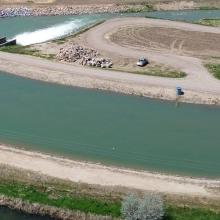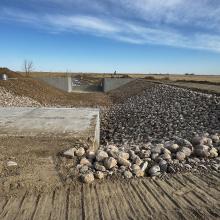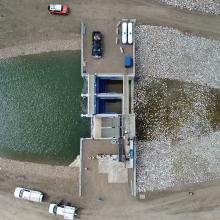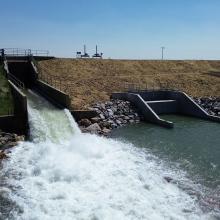Image set

Related services
Related sectors
Related regions
Opening article section
Article section
Rich text
Positioned near the midpoint of the 312-kilometer St. Mary River Irrigation District (SMRID) Main Canal, the Horsefly Regional Emergency Spillway project is a crucial, 14-kilometre-long water infrastructure project located near the town of Taber, in southern Alberta. The spillway redirects excess stormwater from the SMRID Main Canal to the nearby Oldman River, improving flood control and resilience.
Since 2014, MPE, a Division of Englobe has provided critical leadership and technical expertise to ensure the project’s success. As prime consultant, the MPE team was responsible for overseeing every project phase, from initial planning through to final implementation.
Article quote
Media
Image set

Rich text
Stormwater management vulnerabilities and challenges in southern Alberta
In recent years, southern Alberta’s prosperity has stemmed from intense agricultural activity, along with growing residential and industrial development.
This economic progress has brought challenges. Rapid changes in land use, along with extensive irrigation practices and ongoing development, have significantly impacted natural water drainage systems, severely diminishing the land’s natural ability to absorb water.
Rich text
Drainage issues
These issues have become increasingly common, and now pose grave risks to local communities, businesses, infrastructure, and critical potable water resources.
Rich text
Reliance on an irrigation canal system
The region’s reliance on an irrigation canal system presents another challenge. Initially designed for agricultural water delivery, this system has struggled to handle the high stormwater runoff generated by the heavy rain and snowmelt this region has recently experienced.
Rich text
Inability to divert stormwater from the Main Canal
A further critical vulnerability is the absence of a mechanism to divert stormwater from the St. Mary River Irrigation District Main Canal, which supports approximately 200,000 hectares of farmland.
The urgency of addressing these issues became evident following several extreme weather events between 2010 and 2018, which caused widespread flooding and damage across the region.
Media
Image set

Rich text
An urgent response to a critical situation
To address the situation, in 2012 a group of local municipalities, counties, and irrigation districts formed the Southern Regional Stormwater Drainage Committee (SRSDC). This committee identified key priorities, including:
- Preventing injury or loss of life
- Protecting municipal and irrigation district infrastructure
- Safeguarding private property
- Mitigating economic losses caused by flooding
- Supporting agricultural growth and future development
In 2014, MPE and the SRSDC jointly developed and issued the Southern Regional Stormwater Management Plan, which recommended seven flood mitigation projects. Among them, the Horsefly Regional Emergency Spillway project was identified as the highest priority, due to its potential to mitigate flood risks across the entire region.
In January 2021, MPE was selected to lead the project, with Stantec serving as a sub-consultant.
Media
Image set

Rich text
MPE’s scope of work and deliverables for the Horsefly Regional Emergency Spillway project
The MPE team led the Horsefly Regional Emergency Spillway project’s civil, hydrotechnical and structural design, conducted geotechnical investigations, and oversaw environmental compliance.
Rich text
1. Civil and hydrotechnical design
The MPE team undertook the rehabilitation and expansion of 5.6 kilometers of the existing irrigation canal, significantly increasing its capacity from 8 m³/s to 40 m³/s. The canal’s banks were raised to optimize water levels, enhancing its ability to handle higher flows. These improvements also paved the way for future pipeline designs, supporting long-term infrastructure planning.
Throughout the project, the MPE team applied advanced hydrotechnical principles to ensure the system’s efficiency and sustainability. This ensured the project would meet the region’s growing needs for flood control and water management with minimal disruption to the surrounding environment and infrastructure.
Rich text
2. Structural design: challenges and innovative solutions
2.1. Automation
This project integrated a high degree of automation, enabling the remote monitoring and operation of the entire spillway system through SMRID’s SCADA system. This degree of automation enhanced operational efficiency and safety, especially during severe weather events while paving the way for future expansion of SMRID’s irrigation infrastructure.
To ensure real-time system monitoring and efficient management, the MPE team designed five cast-in-place concrete control structures, each equipped with automated systems seamlessly integrated with SMRID’s controls. This approach enables real-time adjustments to water levels and flow rates, optimizing flood management while reducing the need for onsite staff.
2.2. Riprap spillway design and construction
Designing the riprap spillway down the coulee presented a major challenge requiring careful consideration of both hydraulic performance and environmental impact.
The terminal spillway was designed with a 50-meter vertical drop into the Oldman River Valley, stabilized using large-diameter riprap stones. This design provided a cost-effective solution that requires lower maintenance and offers enhanced durability, even with fluctuating water volumes and speeds. This approach minimized erosion while accommodating the steep gradient.
To facilitate construction, the existing drain was realigned, and several large rock drop structures were strategically incorporated to manage flow and reduce erosion. These structures were placed in the most constrained areas with minimal space for construction, a process that required precise planning and innovative engineering.
Rich text
3. Geotechnical approach and services
The MPE team’s geotechnical work included detailed borrow investigations for canal rehabilitation, and slope stability investigations (in partnership with Stantec) through the steep coulee section.
Through these investigations, the team identified the materials required for canal rehabilitation and assessed the slopes to prevent erosion. These investigations also informed the project’s design and construction phases, mitigating potential risks and ensuring the infrastructure’s safety and durability.
Construction challenges
During the construction phase, the MPE team encountered complex geotechnical challenges, including frequent groundwater inflows and variable soil types.
The team addressed these issues by identifying and utilizing scattered clay pockets within the project site to create impermeable embankments, essential for stabilizing the canal and spillway. This approach minimized external material requirements and reduced overall project costs.
Rich text
4. Environmental compliance
Designed to support local biodiversity, the spillway includes strategic alignments to preserve natural wildlife corridors. This ecofriendly design serves to maintain natural migration patterns and minimizes disruptions to local species.
Special attention was given to enabling the movement of deer and other animals and to preserving two nearby winter hibernation zones used by rattlesnakes.
Rich text
5. Collaboration with regulatory bodies and Indigenous communities
The Horsefly Regional Emergency Spillway project was built in compliance with Alberta’s water management and environmental protection standards, and therefore required consultation with 14 First Nations and 16 federal and provincial agencies. The MPE team’s early and continuous engagement with these stakeholder groups was key to efficiently obtaining the required approvals.
Media
Image set

Rich text
A host of benefits provided by the Horsefly Regional Emergency Spillway project
Completion of the first portion of this project - deemed essential to safeguard critical infrastructure and support the region’s continued economic growth - delivered tangible benefits:
- Enhanced flood protection
- Agricultural stability and economic growth
- Environmental benefits
- Community resilience
- Improved infrastructure
Media
Image set

Rich text
A promising phase of a critical project
The MPE team’s contributions ensured this phase of the overall Horsefly Regional Emergency Spillway project addressed urgent priorities such as:
- protecting human health and lives,
- safeguarding infrastructure and property, and
- mitigating economic losses
- while supporting regional growth and prosperity.
This project represents a crucial regional investment, enhancing resilience to extreme weather events, and maintaining the prosperity of this rapidly-growing region.
Media
Image set
